What Is a Nutcracker Soldier: Unveiling the Classic Christmas Icon
A nutcracker soldier is a fascinating decorative item often associated with the Christmas season. Traditionally crafted to look like a toy soldier, these charming figurines have a rich history that dates back to 17th-century Europe. They were originally utilised as practical tools for cracking nuts but evolved over time to become beloved festive ornaments with symbolic value. My fascination with these items lies in their unique blend of practicality and whimsy, which captures the imagination and brings a touch of nostalgia during the holiday period.
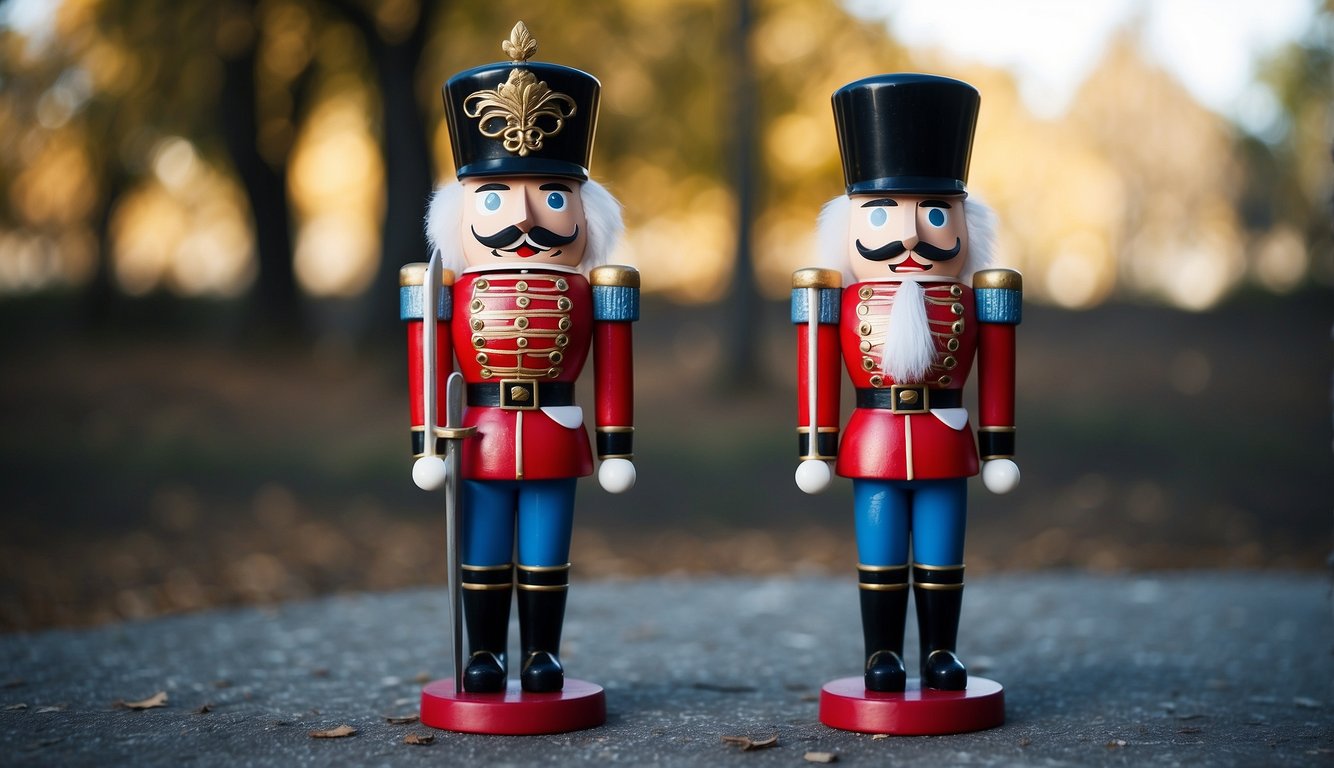
The design of a nutcracker soldier is quite distinctive, with a strong jawline that serves both a functional and aesthetic purpose. Usually made of wood, the lever-like mechanism that makes up their mouths is what enables them to crack shells between their teeth. Beyond their utility, the intricate detail and craftsmanship involved in creating each soldier contribute to their appeal as collectables. At my place, they stand proudly on the mantelpiece, contributing to the warm and festive atmosphere typical of the yuletide season.
Key Takeaways
- Nutcracker soldiers are traditional Christmas ornaments with practical origins.
- They feature a distinctive design that blends functionality with ornamental charm.
- Collecting these figurines is a popular hobby that also involves care and preservation.
Origins and History
The Nutcracker soldier, a charming Christmas icon, has a rich history that begins in the forests of Germany and spans literature and ballet. Let's take a stroll through the past and discover the story of these wooden guardians.
Early Beginnings
Nutcrackers, specifically the wooden soldier kind, date back to the Ore Mountains of Germany. As early as the 14th century, wood carving was a substantial industry in these regions, but the nutcracker as we know it emerged later. It was crafted using a lathe, a tool instrumental in woodworking, which allowed artisans to turn simple blocks of wood into intricate figures.
German Tradition
My fascination with nutcrackers is deeply rooted in Germany's history. By the 19th century, the nutcracker soldier had become a symbolic protector of the home. According to lore, these stoic figures would act as guardians, bringing good fortune and safeguarding the family. The tradition of gifting these effigies, particularly during Christmas, underscores their significance in home and hearth.
The Nutcracker in Literature
E. T. A. Hoffmann's story, "The Nutcracker and the Mouse King," penned in 1816, is crucial to the history of the Nutcracker. My appreciation for this literary work grew as it showcased a magical world where the Nutcracker comes to life, highlighting the mystical aura surrounding these wooden figures.
Ballet Adaptation
The history of the Nutcracker soldier wouldn't be complete without mentioning Pyotr Ilyich Tchaikovsky's ballet adaptation. Since its premiere in 1892, "The Nutcracker" ballet has enchanted audiences worldwide, becoming a Christmas tradition in its own right. This adaptation has cemented the nutcracker's status not just as a festive decor, but as a symbol of cultural and artistic heritage.
Design and Functionality
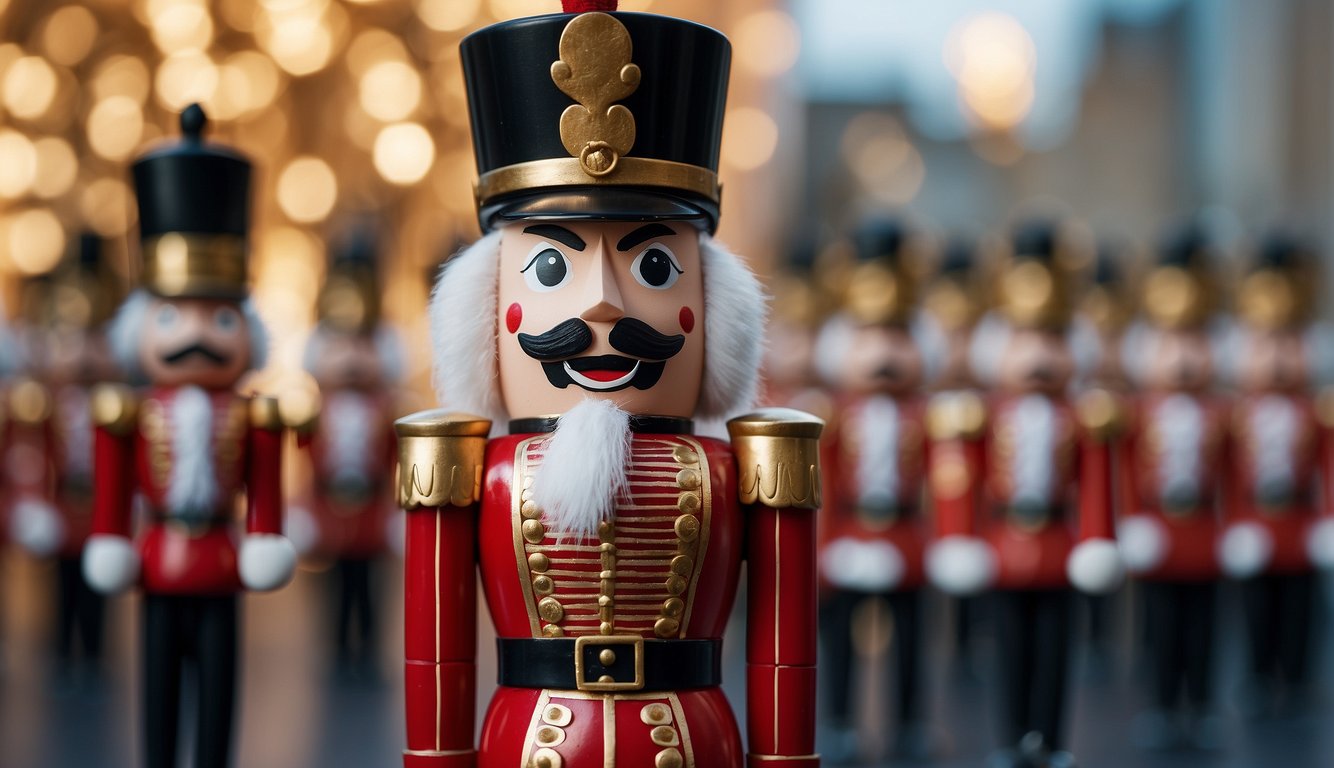
In exploring the world of nutcrackers, particularly the soldier variety, I'll examine their practical design alongside the captivating artistry that makes them cherished far beyond their utilitarian purpose.
Anatomy of a Nutcracker
When it comes to nutcracker soldiers, my attention is first drawn to their anatomy. These figures typically feature a lever at the back that serves as the handle. By pressing down on this lever, the jaw—often styled to look like it's part of a character's mouth—moves to crack the nut placed in the hinge. The unique form, evoking images of ore-turned soldiers, combines form with function.
Mechanism and Use
The key to a nutcracker's function lies in the simple yet effective mechanism of leverage. Lever nutcrackers amplify my force to easily crack open tough shells. I find that the jaw and handle work together, where applying pressure to the handle causes the jaw to clamp down. It's not only about soldiers; there are screw nutcrackers which use a twisting motion to crack nuts, and those fashioned on a lathe for a perfectly smooth finish.
Artistry and Craftsmanship
My appreciation for a nutcracker deepens when considering the artistry and craftsmanship. Crafted with an array of materials—from woods to metals, and often adorned with intricate details—they're a testament to the skill of artisans. Whether turned on a lathe for precision or painted by hand, each piece tells its own story through its craftsmanship.
Cultural Significance
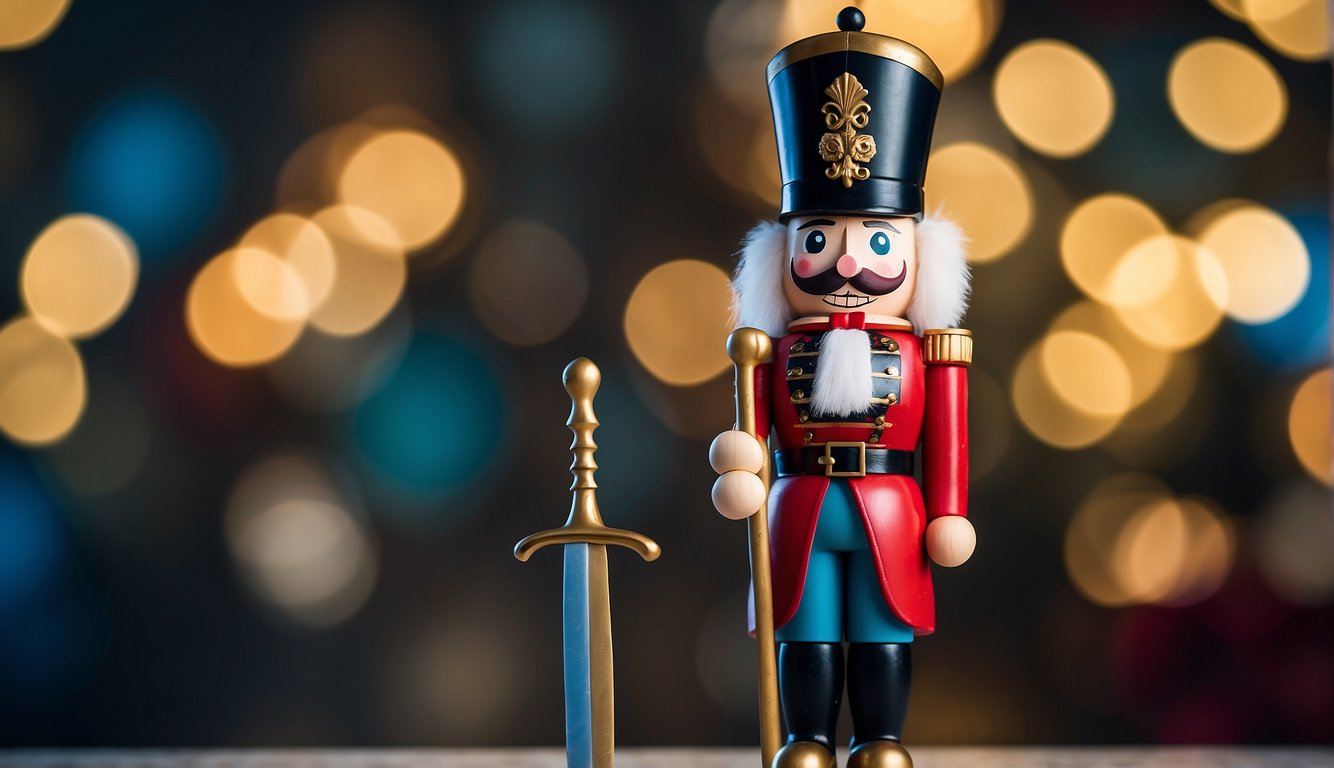
The nutcracker soldier isn't just a decorative piece; it carries a wealth of cultural importance that has evolved over centuries. These ornamental figures embody a mix of folklore, festivity, and family traditions during the Christmas season.
Symbolism and Tradition
Nutcracker soldiers are a traditional symbol of Christmas, and I reckon there's more to them than meets the eye. Originating in Germany, these figurines are symbols of good luck meant to ward off malevolent spirits and protect the home. It's a tradition that many believe strengthens family bonds, bringing luck and prosperity to households. Their appearance as soldiers showcases attributes such as strength and steadfastness, echoing themes of protection and power.
Nutcrackers in Modern Celebrations
As a festive holiday decor, the popularity of nutcracker soldiers has burst beyond its German roots to become integral to the Christmas celebrations in the United States and around the globe. The ballet The Nutcracker has played a massive role in this, with its vibrant and bright performances that capture the essence of the Yuletide spirit. For many American families, these figures are not just decorations but also reminiscent of the American soldiers away from home during the holidays. Over the years, I've noticed that the appeal of nutcrackers has expanded even further, becoming collectible items representing a touch of royalty and the whimsy of Christmas.
Collecting and Care
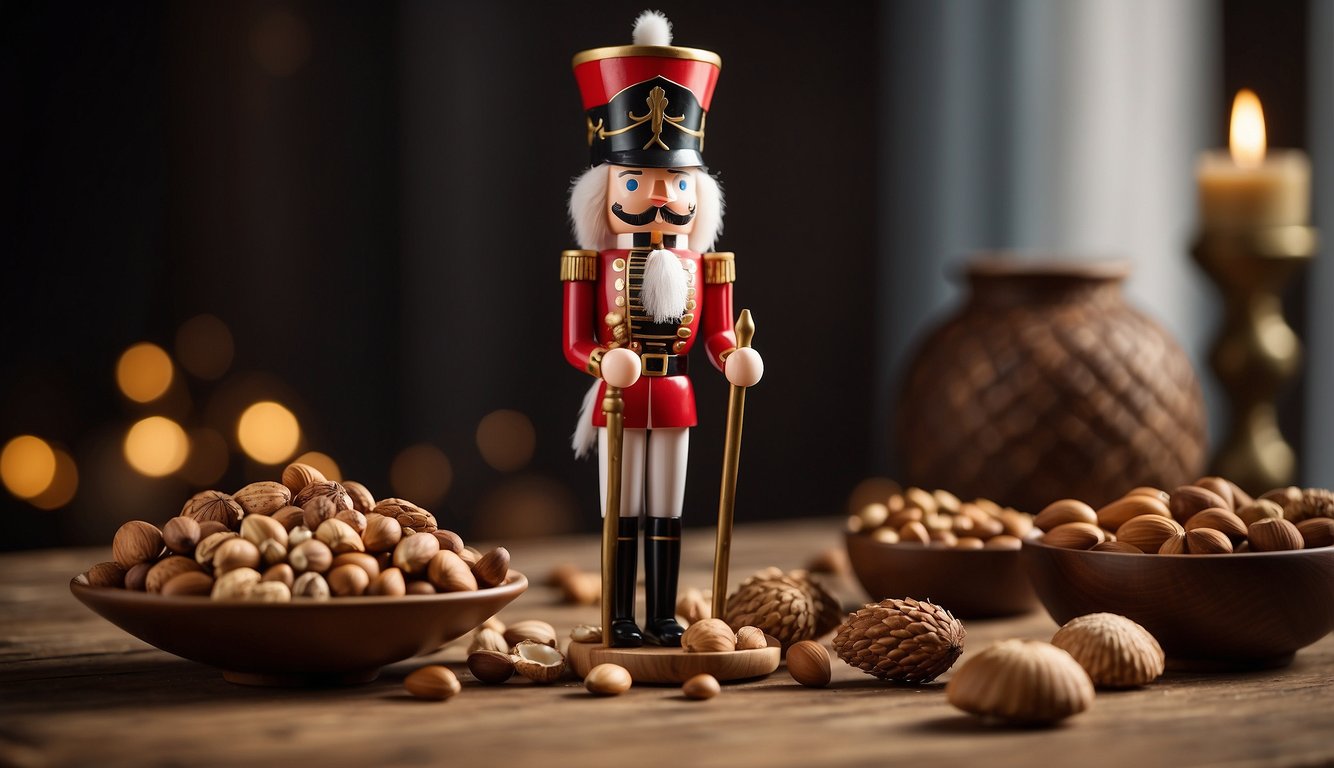
I've found that one of the joys of collecting nutcracker soldiers is not just in their festive charm but also in the history and craftsmanship they represent. I'm here to help you understand the essentials of showcasing and preserving your collection.
Nutcracker Museums
I'm absolutely taken by the dedication to nutcracker soldiers you'll find at nutcracker museums, such as the Leavenworth Nutcracker Museum. It's an enchanting place where these timeless pieces are not just displayed but also celebrated. If you've got a passion for nutcracker soldiers, perhaps you'll consider donating to a museum. After all, what better gift to the community than sharing the splendour of your collection?
Preservation Tips
Now, let me share with you some nifty preservation tips. After investing time and resources into collecting nutcracker soldiers, it becomes vital to focus on their care to maintain their aesthetics and functional integrity. Here's what I suggest:
- Handling: Always hold your nutcracker soldiers gently by the base, avoiding any painted surfaces to minimise wear.
- Cleaning: Dust them regularly with a soft, dry brush. Avoid harsh chemicals which might damage the paint or wood.
- Storage: In the off-season, store your nutcrackers in a cool, dry place. Wrap them in acid-free paper to prevent discolouration or moisture damage.
- Display: Keep them out of direct sunlight when on display to prevent the colours from fading.
By following these simple tips, I reckon you can keep your nutcrackers in tip-top shape for many Christmases to come!
Check out our other blog posts
What Is a Flocked Christmas Tree: Your Guide to Frosty Festive Decor
A flocked Christmas tree is a visually stunning centrepiece for Yuletide celebrations, capturing the essence of a winter's snowfall indoors.
This delightful decoration is achieved by applying a white powder, creating the illusion of fresh, powdery snow adorning the pine's lush green branches.
Flocking can be found on both natural and artificial trees, allowing for the wintry charm of Christmas to be enjoyed regardless of climate or geography.

The practice of flocking adds a touch of wintry magic to the Christmas tree, transforming living rooms into a winter wonderland. While real snow is fleeting, flocked trees retain their pristine, snowy appearance throughout the holiday season. It's a tradition that can turn an ordinary tree into an enchanting focal point of the season's festivities.
Key Takeaways
- Flocked Christmas trees provide a snowy, winter wonderland aesthetic indoors.
- They can be either purchased pre-flocked or decorated at home using special flocking materials.
- Proper maintenance is required to preserve the tree's snowy appearance throughout the holidays.
Understanding Flocked Christmas Trees
In this part, I'm excited to share the charm and history behind flocked Christmas trees, the process known as flocking that gives them their snowy appearance, and the various types you can find.
Historical Background
Flocked Christmas trees have brought a touch of winter wonder to homes since as early as the 1800s. However, the technique popularised in the 1950s when people desired to create a white Christmas effect indoors. The trend has since evolved, with both artificial and real trees being adorned with what's affectionately known as fake snow.
What Is Flocking?
Flocking involves applying a fluffy, white substance to emulate the look of a tree dusted by snow. This coating, often made of cellulose or cotton, is sprayed onto the tree's branches to create that magical winter feel that's especially loved during the Christmas season.
Types of Flocked Trees
Flocked Christmas trees come in various styles and sizes:
- Artificial Tree: Often made from PVC plastic, these mimic the look of real trees and are the most common type of flocked trees you'll find.
- Real Tree: You can also flock natural trees, giving them a more authentic yet snowy look that's simply stunning.
Whether you choose an artificial flocked tree for its convenience or a real one for its natural beauty, both add a festive, wintery charm to your home.
Pros and Cons of Flocking
Before we dive into the specifics, it's key to know that flocking a Christmas tree can greatly enhance its appearance, but it may also bring about some practical considerations. Let's look at both sides to find out what suits your festive needs the best.
Aesthetics and Theming
I reckon the main draw to flocking is the visual appeal. Flocking gives your Christmas tree that quintessential winter wonderland vibe, even in the Aussie summer heat. There's something quite magical about a white, snow-kissed tree that makes the whole room sparkle. Besides, it's tops for theming; whether you're after a traditional look or something more modern, flocking blends in seamlessly.
Practical Considerations
On the practical side of things, flocking isn't without its drawbacks. For instance, a flocked Christmas tree can be messy. When I first dropped a bit of flocking on my carpet, I learned that it can shed, just like the needles of a real tree. And while maintenance isn't a massive hassle, it might need a bit more looking after to keep it looking schmick, especially when it comes to cleaning up those stray bits.
For anyone who has allergies or sensitivities, take note that the flocking material can sometimes trigger a reaction. And if being environmentally friendly is a priority for you, it's worth considering that flocking – particularly the DIY variety – isn't always the most sustainable option. But there are eco-friendlier choices out there if you do a bit of digging.
Maintenance and Care

In my experience, looking after a flocked Christmas tree requires a bit of extra attention, especially as we're dealing with those stunning snowy tips that make the tree so special. I'll help you understand how to keep your tree looking magical with simple cleaning tips and proper storage methods.
Cleaning and Upkeep
Keeping my flocked Christmas tree clean and vibrant starts with regular dusting. I find that using a soft-bristled brush helps to gently remove any accumulated dust without disturbing the flocking too much. If you have lights and ornaments on your tree, take care to dust them too, as they can gather dust just as the needles do.
Now, flocked trees can get a bit messy, particularly when they start shedding. To minimise the mess, I use a vacuum with a hose attachment to pick up the flock that's fallen off. It's important to avoid the base of the tree where moisture can cause residue; this is where a small, handheld vacuum can be handy for precision.
Whenever I'm working on my tree, if I find that the flocking is creating a lot of dust in the air, I sometimes put on a mask to avoid breathing it in. It's not often necessary, but it's a good precaution if you find the dust irritating.
Storing Your Flocked Tree
When the festive season wraps up, and it's time to put my flocked tree away, storing it correctly is crucial to maintaining its beautiful appearance for next year. I always ensure that my tree is completely dry, with no moisture trapped on the branches. Storing the tree in a cool, dry place is essential to prevent any mildew or mould.
I use a Christmas tree storage bag that's designed to handle a flocked tree's delicate nature. Before packing it away, I make sure to remove all the lights and ornaments to avoid any unnecessary pressure on the branches, which could cause more shedding. Gently folding the branches and making sure that the bag is sealed will keep out dust and other particles that could stick to the residue of the flocking.
It's these little steps that can ensure your flocked Christmas tree stays as beautiful as the day you got it, ready to spread cheer when the season comes around again.
DIY Flocking at Home

Creating a flocked Christmas tree in the comfort of my own home allows me to bring a touch of winter magic indoors. I enjoy the flexibility of tailoring the amount of 'snow' to match my personal style, without the worry of using toxic materials.
Materials Needed
For a successful DIY flocking, these materials are essential:
- Adhesive: A mixture I find effective is watered-down white glue or a non-toxic spray adhesive to act as the bonding agent.
- Flocking Mixture: Common and safe options include shaving cream blended with cornstarch or a mix of flour. For a sparkly effect, some crafters like to mix in fine, non-toxic glitter.
- Application Tools: A sifter for even distribution of the powder and a spray bottle to mist water, activating the adhesive.
- Protective Gear: To avoid any mess, I wear old clothing and lay down newspapers or a drop cloth.
Step-by-Step Guide
Creating your flocked tree is a simple process when these steps are followed:
-
Preparation: I start by setting up my workspace outdoors if possible, for ventilation and easy cleanup. In any case, I ensure the area is well-protected.
-
Base Layer: Using the spray bottle, I lightly mist my tree with water - this helps the flocking mixture to adhere better.
-
Flocking: I apply the adhesive where I want the 'snow' to stick. Then, while the adhesive is still wet, I sift the flocking mixture onto the branches.
-
Setting: After I've achieved the desired look, I let the tree sit to dry thoroughly. This could take up to 24 hours, depending on the humidity and the thickness of the flocking.
During this exciting project, I always ensure I'm using sustainable and non-toxic materials for my health and the environment's sake. Plus, it's a fantastic way to express myself and add a personalised touch to the festive season.
How to Decorate a White Christmas Tree: Stylish Tips and Tricks
Decorating a white Christmas tree is an exciting holiday activity that allows for creativity and can brighten up any space during the festive season. I believe the key to a beautiful white Christmas tree is to choose a cohesive theme that reflects your personal style or the overall aesthetic of your home.
Whether you prefer a traditional look with red and gold accents or something more modern like a monochromatic scheme, a white tree serves as a blank canvas that enhances whatever decorations you choose.

Once the theme is decided, selecting the right ornaments is crucial. I find that starting with the larger ornaments and placing them evenly around the tree gives it a balanced look. Then, layering in smaller ornaments can fill in the gaps and add depth. Don't be afraid to mix textures and finishes, such as shiny, matte, and glittered decorations, which can all contribute to a dynamic appearance. Lastly, considering additional decorative elements such as garlands, ribbons, or a spectacular tree topper can provide that finishing touch, elevating the white tree to a stunning holiday centerpiece.
Key Takeaways
- Selecting a decor theme personalises the white Christmas tree to your style.
- Placement of large to small ornaments creates a balanced and dynamic appearance.
- Adding finishing touches with garlands and a topper elevates the tree's visual appeal.
Choosing Your Decor Theme
Before we start elaborating on various decor themes, it's essential to realise that the theme sets the tone for your white Christmas tree. It's the foundation upon which you'll layer different elements, such as baubles, lights, and tinsel, to create a cohesive look.
Classic Elegance
My love for timeless aesthetics draws me to the Classic Elegance theme. I tend to prefer decorations in shades of silver and gold, which beautifully reflect the tree's lights. Introducing shiny baubles, twinkling fairy lights, and even some vintage decorations can bring out an old-world charm that feels both sophisticated and heart-warming.
Rustic Charm
Nothing speaks to my heart like the Rustic Charm theme. To achieve this, I incorporate natural textures using burlap ribbons and wooden ornaments. I also like adding pine cones and a selection of woodland creatures, which complement the tree with an earthy and grounded feel.
Winter Wonderland
Creating a Winter Wonderland is all about capturing the essence of a snowy landscape. I'll use frosty decorations, sparkling snowflakes, and glittery icicles to simulate a magical, frost-kissed forest. This theme can be enhanced by incorporating soft, white lighting to mimic the serene glow of snow.
Vibrant and Colorful
Sometimes, I'm in the mood for something lively and bright, so I go for a Vibrant and Colorful theme. Colorful ornaments, such as multicoloured baubles and ribbons, stand out strikingly against the white backdrop of the tree. If I'm feeling particularly bold, I might even add a vibrant tree topper to serve as the centrepiece.
Ornament Selection and Placement
When I deck out my white Christmas tree, I pay careful attention to the types of ornaments I select and where they go. My strategy is all about creating balance and harmony with a touch of personal flair.
Hanging Ornaments Strategically
I start by hanging my star on top because it sets the tone for the rest of the tree. I ensure the star is secure and straight, as it's the crown of my snowy Christmas display. Next, I distribute silver ornaments evenly throughout the branches; their reflective surfaces catch the light beautifully and complement the white backdrop of the tree. Gold and pearly ornaments follow, adding warmth and elegance. For a pop of colour, I intersperse red ornaments, ensuring they're not clustered together, which might overwhelm the look. Black ornaments can offer a modern twist, but I use them sparingly to maintain a sophisticated palette.
Combining Various Ornament Types
My tree dazzles with a mix of glass ornaments, which I hang closer to the tree trunk to protect them from accidental brushes. I love to weave a ribbon down the tree in a spiral fashion, choosing one that matches my colour scheme; this year, I'm favouring a soft gold. Lastly, I scatter lightweight, shimmering ornaments near the tips of the branches for a balanced aesthetic. Each ornament type holds a place in my storytelling, from the sparkle of glass to the lustre of metallics, contributing to a well-rounded and inviting festive display.
Additional Decorative Elements
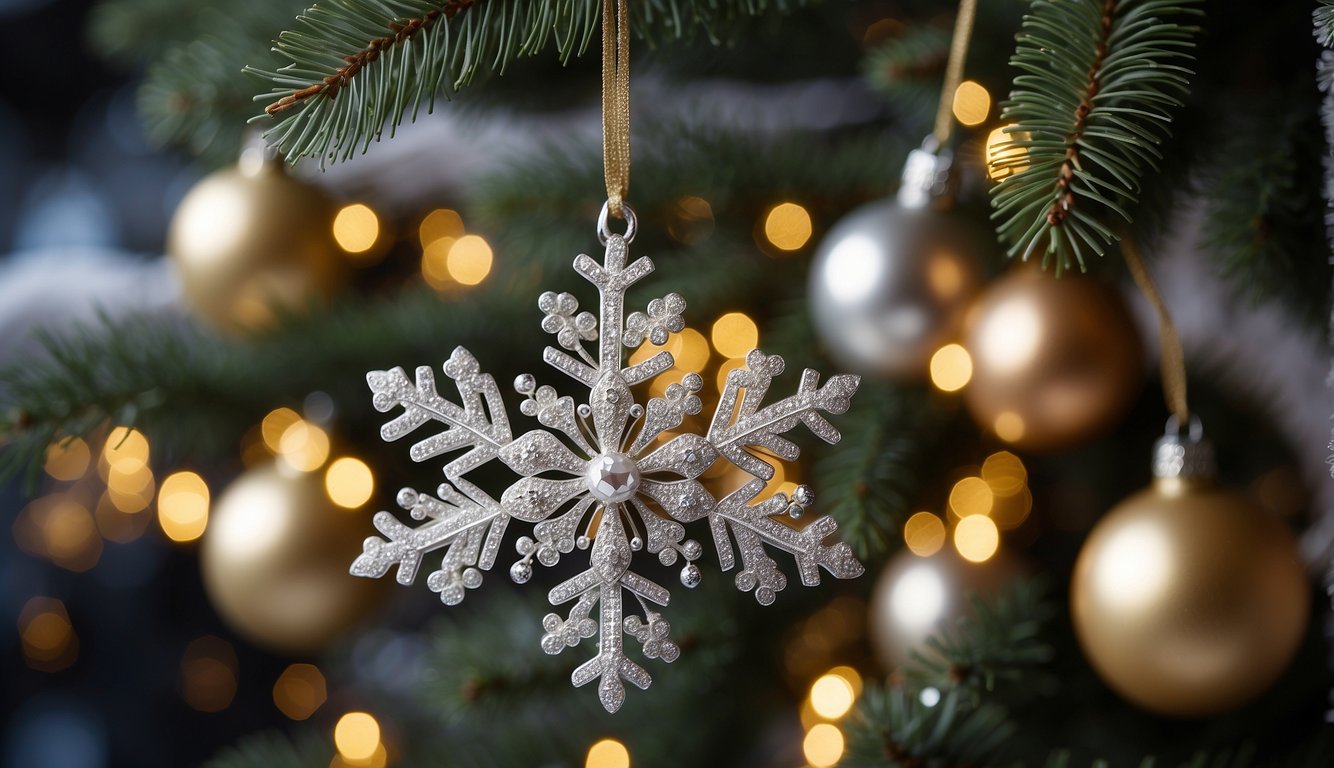
When I decorate my white Christmas tree, I love to add elements that enhance its elegance and bring an extra layer of style. Here are a couple of special touches I always consider:
Incorporating Garlands and Ribbons
To start, I find that elegantly draping garlands from top to bottom adds depth and texture to the tree. I alternate between shiny and matte finishes to keep the eye moving. Then, I weave in ribbons of varied widths through the branches, letting them cascade down for a flowing effect. Burlap ribbons lend a rustic charm, while satin or velvet ribbons offer a touch of luxury.
- Garlands: Burlap, twine, or even delicate beading
- Ribbons: Wide, glistening satin ribbons or narrower, patterned options
Using Foliage and Nature-Inspired Accents
My next step is to introduce a bit of nature. I love tucking in white branches to mimic the look of a forest touched by frost. It's amazing how something as simple as spraying a bit of faux snow on pinecones or feathers can transform a tree. For those who appreciate a woodsy theme, adding sprigs of greenery, pine cones, or even little nutcrackers peeking through the foliage brings whimsy and natural charm.
- Foliage: Sprigs of green, pine cones, leaves
- Woodsy Accents: Feathers, wooden twigs, or woodsy themed picks
By incorporating these elements, my tree always feels unique, personal, and wonderfully festive.
Finishing Touches and Accessories

When I decorate my white Christmas tree, I pay special attention to the finishing touches and accessories. These final elements pull the whole look together and can transform the tree into a true masterpiece.
Setting Up the Tree Base
For a sturdy and stylish foundation, I like to use a basket. It adds a rustic appeal and keeps the tree stable. If I'm aiming for a more luxurious feel, a faux fur tree skirt works brilliantly. It's soft and adds a layer of texture that complements the stark whiteness of a flocked tree.
Creating a Focal Point
The topper is my centrepiece; it's what draws the eye and sets the tone for my tree's decor. I often opt for a geometric white star topper for a modern twist that still honours tradition. Adding metallic accents around the topper, like champagne coloured baubles, introduces a warm shine that contrasts nicely against the icy white branches. For a more shabby chic look, I might choose a mix of neutral decor with pops of red, subtly introducing candy cane themed accessories to give a nostalgic yet fresh ambiance.
What Is a Nutcracker Soldier: Unveiling the Classic Christmas Icon
A nutcracker soldier is a fascinating decorative item often associated with the Christmas season. Traditionally crafted to look like a toy soldier, these charming figurines have a rich history that dates back to 17th-century Europe. They were originally utilised as practical tools for cracking nuts but evolved over time to become beloved festive ornaments with symbolic value. My fascination with these items lies in their unique blend of practicality and whimsy, which captures the imagination and brings a touch of nostalgia during the holiday period.

The design of a nutcracker soldier is quite distinctive, with a strong jawline that serves both a functional and aesthetic purpose. Usually made of wood, the lever-like mechanism that makes up their mouths is what enables them to crack shells between their teeth. Beyond their utility, the intricate detail and craftsmanship involved in creating each soldier contribute to their appeal as collectables. At my place, they stand proudly on the mantelpiece, contributing to the warm and festive atmosphere typical of the yuletide season.
Key Takeaways
- Nutcracker soldiers are traditional Christmas ornaments with practical origins.
- They feature a distinctive design that blends functionality with ornamental charm.
- Collecting these figurines is a popular hobby that also involves care and preservation.
Origins and History
The Nutcracker soldier, a charming Christmas icon, has a rich history that begins in the forests of Germany and spans literature and ballet. Let's take a stroll through the past and discover the story of these wooden guardians.
Early Beginnings
Nutcrackers, specifically the wooden soldier kind, date back to the Ore Mountains of Germany. As early as the 14th century, wood carving was a substantial industry in these regions, but the nutcracker as we know it emerged later. It was crafted using a lathe, a tool instrumental in woodworking, which allowed artisans to turn simple blocks of wood into intricate figures.
German Tradition
My fascination with nutcrackers is deeply rooted in Germany's history. By the 19th century, the nutcracker soldier had become a symbolic protector of the home. According to lore, these stoic figures would act as guardians, bringing good fortune and safeguarding the family. The tradition of gifting these effigies, particularly during Christmas, underscores their significance in home and hearth.
The Nutcracker in Literature
E. T. A. Hoffmann's story, "The Nutcracker and the Mouse King," penned in 1816, is crucial to the history of the Nutcracker. My appreciation for this literary work grew as it showcased a magical world where the Nutcracker comes to life, highlighting the mystical aura surrounding these wooden figures.
Ballet Adaptation
The history of the Nutcracker soldier wouldn't be complete without mentioning Pyotr Ilyich Tchaikovsky's ballet adaptation. Since its premiere in 1892, "The Nutcracker" ballet has enchanted audiences worldwide, becoming a Christmas tradition in its own right. This adaptation has cemented the nutcracker's status not just as a festive decor, but as a symbol of cultural and artistic heritage.
Design and Functionality

In exploring the world of nutcrackers, particularly the soldier variety, I'll examine their practical design alongside the captivating artistry that makes them cherished far beyond their utilitarian purpose.
Anatomy of a Nutcracker
When it comes to nutcracker soldiers, my attention is first drawn to their anatomy. These figures typically feature a lever at the back that serves as the handle. By pressing down on this lever, the jaw—often styled to look like it's part of a character's mouth—moves to crack the nut placed in the hinge. The unique form, evoking images of ore-turned soldiers, combines form with function.
Mechanism and Use
The key to a nutcracker's function lies in the simple yet effective mechanism of leverage. Lever nutcrackers amplify my force to easily crack open tough shells. I find that the jaw and handle work together, where applying pressure to the handle causes the jaw to clamp down. It's not only about soldiers; there are screw nutcrackers which use a twisting motion to crack nuts, and those fashioned on a lathe for a perfectly smooth finish.
Artistry and Craftsmanship
My appreciation for a nutcracker deepens when considering the artistry and craftsmanship. Crafted with an array of materials—from woods to metals, and often adorned with intricate details—they're a testament to the skill of artisans. Whether turned on a lathe for precision or painted by hand, each piece tells its own story through its craftsmanship.
Cultural Significance

The nutcracker soldier isn't just a decorative piece; it carries a wealth of cultural importance that has evolved over centuries. These ornamental figures embody a mix of folklore, festivity, and family traditions during the Christmas season.
Symbolism and Tradition
Nutcracker soldiers are a traditional symbol of Christmas, and I reckon there's more to them than meets the eye. Originating in Germany, these figurines are symbols of good luck meant to ward off malevolent spirits and protect the home. It's a tradition that many believe strengthens family bonds, bringing luck and prosperity to households. Their appearance as soldiers showcases attributes such as strength and steadfastness, echoing themes of protection and power.
Nutcrackers in Modern Celebrations
As a festive holiday decor, the popularity of nutcracker soldiers has burst beyond its German roots to become integral to the Christmas celebrations in the United States and around the globe. The ballet The Nutcracker has played a massive role in this, with its vibrant and bright performances that capture the essence of the Yuletide spirit. For many American families, these figures are not just decorations but also reminiscent of the American soldiers away from home during the holidays. Over the years, I've noticed that the appeal of nutcrackers has expanded even further, becoming collectible items representing a touch of royalty and the whimsy of Christmas.
Collecting and Care

I've found that one of the joys of collecting nutcracker soldiers is not just in their festive charm but also in the history and craftsmanship they represent. I'm here to help you understand the essentials of showcasing and preserving your collection.
Nutcracker Museums
I'm absolutely taken by the dedication to nutcracker soldiers you'll find at nutcracker museums, such as the Leavenworth Nutcracker Museum. It's an enchanting place where these timeless pieces are not just displayed but also celebrated. If you've got a passion for nutcracker soldiers, perhaps you'll consider donating to a museum. After all, what better gift to the community than sharing the splendour of your collection?
Preservation Tips
Now, let me share with you some nifty preservation tips. After investing time and resources into collecting nutcracker soldiers, it becomes vital to focus on their care to maintain their aesthetics and functional integrity. Here's what I suggest:
- Handling: Always hold your nutcracker soldiers gently by the base, avoiding any painted surfaces to minimise wear.
- Cleaning: Dust them regularly with a soft, dry brush. Avoid harsh chemicals which might damage the paint or wood.
- Storage: In the off-season, store your nutcrackers in a cool, dry place. Wrap them in acid-free paper to prevent discolouration or moisture damage.
- Display: Keep them out of direct sunlight when on display to prevent the colours from fading.
By following these simple tips, I reckon you can keep your nutcrackers in tip-top shape for many Christmases to come!
How Do You Get Inflatables to Stay Up for Christmas? Securing Your Holiday Decorations
As a Christmas enthusiast, I know there's nothing quite like the sight of festive inflatables to really make your yard the talk of the neighbourhood. From giant Santas to twinkling reindeer, these decorations can add loads of festive cheer to your home.
I've found it can be quite tricky to keep these jolly giants standing throughout the Christmas season. It's important to ensure that they're properly set up and secured to withstand wind and weather, ensuring they stay up for the entire holiday period.

Setting up Christmas inflatables involves more than just plugging them in and watching them rise. I've learned that taking extra steps to secure them firmly to the ground is key.
Whether it's using the right weights or tethering them to sturdy fixtures, a bit of preparation goes a long way. Beyond just keeping them upright, I also think about the best ways to maintain and store my decorations to make sure they last many Christmases to come.
Key Takeaways
- Proper setup and securing are imperative for keeping inflatables upright.
- Inflatables should be maintained throughout the season to ensure longevity.
- After the holidays, storing decorations correctly safeguards them for future use.
Setting Up Your Christmas Inflatables
When I set up my Christmas inflatables, I take special care to choose the right spot, closely follow the provided instructions, and inflate them with precision. Each step ensures my outdoor Christmas decorations bring joy without any hiccups.
Choosing the Right Location
I always ensure that the location I choose for my inflatable Christmas decorations is on flat ground. It's crucial to prevent any sharp objects and hard edges that might puncture the material. I stay clear of potential hazards and make certain the inflatables are visible for everyone to enjoy their festive cheer.
Following the Instructions
Each inflatable decoration comes with instructions specific to its design and material. I take the time to read these thoroughly before I begin. Attention to detail during this stage is key, as it's not just about inflating the decoration, but also about securing it properly to withstand the elements.
Inflating with Care
Inflating requires care. I ensure that my inflatable decorations are not exposed to heat sources that could damage them. Gradual inflating allows the material to expand evenly, reducing the risk of tears or warping that might occur if I rush the process.
Securing Inflatables Against the Elements
When I prep my Christmas inflatables, I make sure they can stand up to wind, rain, and the occasional frosty day. I've got a few tricks up my sleeve to keep everything merry and bright, even in the choppiest of weathers.
Protecting from Wind and Weather
Wind and rough weather are the main concerns when I put out my Christmas inflatables. I always use strong rope or twine for extra stability, which prevents my cheerful display from turning into a runaway holiday spectacle. I find that placing them in areas with some protection from the wind, such as near a wall or fence, makes a huge difference.
Anchoring Techniques
The technique I use to secure my inflatables really depends on the terrain. If I'm setting up on soil, I'll use stakes driven into the ground, with each stake connected to the inflatable's built-in tethers. For hard surfaces, I rely on sandbags and weight to keep things grounded. It's the tension that's the key; I adjust it to be tight enough to hold, but not so tight that it tears the fabric.
Dealing with Rain, Snow, and Ice
Dealing with the wet stuff means I need to ensure everything is waterproof or at least water-resistant. I check for weather-safe electrical parts and leads, and to stop water pooling on top of my inflates, I position them so they're not completely flat.
When snow or ice is forecast, I'll sometimes deflate my inflatables temporarily to avoid any damage. Frosty weather calls for a tie-down stake regimen that I double-down on, making sure everything is snug as a bug and not going anywhere.
Maintaining and Storing Decorations
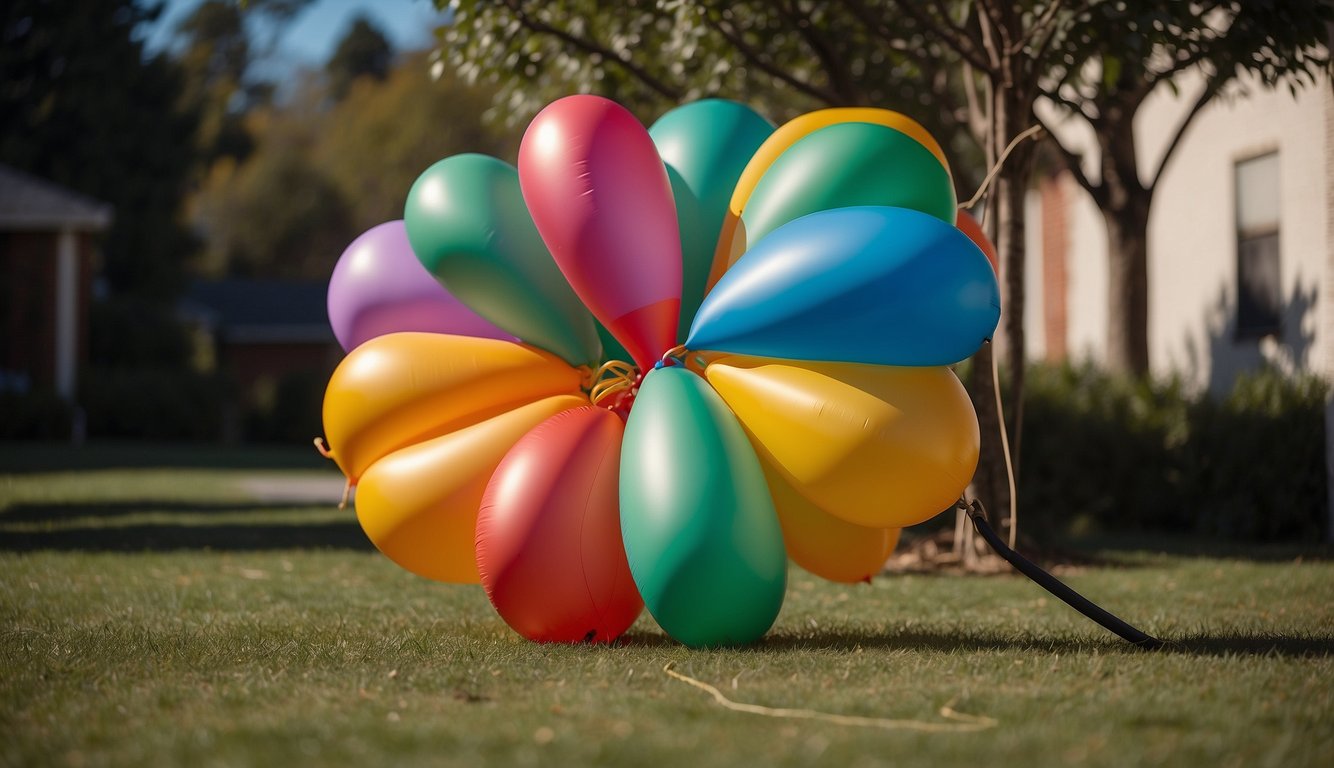
When I set up my Christmas inflatables, I ensure they stay pristine and look great each festive season. It's all about giving them a bit of tender loving care and packing them away properly.
Routine Care and Cleaning
I make it a point to regularly check my Christmas inflatables for any dirt or debris. I gently clean them using a mild detergent and a soft cloth to avoid damage. Afterward, I let them air dry completely before the next use. This simple routine ensures my festive friends are always ready to impress the neighbours.
Packing Away Post-Christmas
Once the holiday cheer has wound down, I deflate my decorations carefully, ensuring they are dry to prevent mould. I then fold them neatly, akin to packing away clothes, and place them back into their original packaging if possible, or a heavy-duty storage bag that keeps out moisture and pests.
I've found the perfect way to store inflatable decorations is to keep them in a cool, dry place until they're needed again next Christmas.
Additional Tips for Holiday Cheer
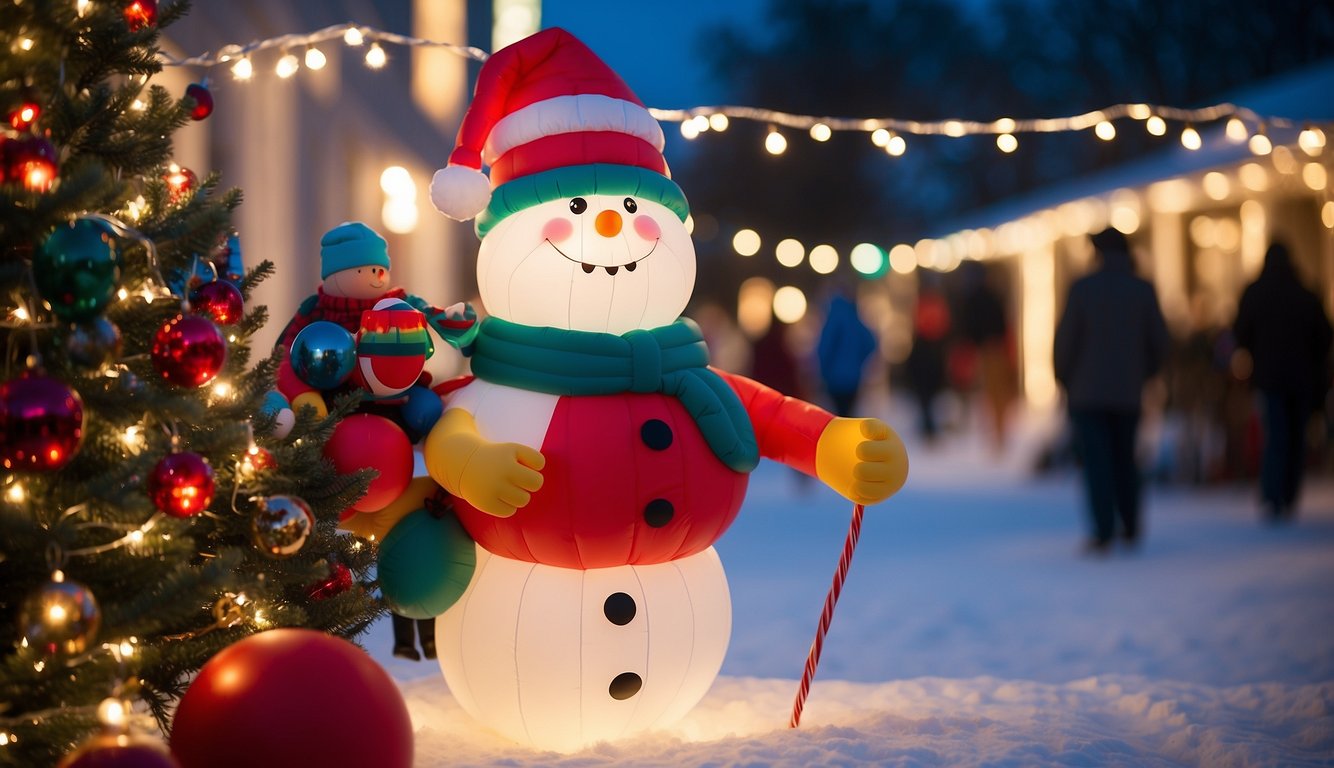
When I deck the halls with bouncy holiday cheer, there are a couple of special tricks I use to enhance my festive display and keep everything secure.
Incorporating Lights and Other Decorations
I find that carefully choosing and positioning lights can maximise the festive feel of my inflatable decorations. I often opt for LED lights because they're energy-efficient and come in bright colours that make Santa and his reindeer pop.
Wrapping a string of Christmas lights around my inflatables gives them a merry glow, and arranging spotlights to highlight each figure creates a dynamic scene. Also, complementing inflatables with static decorations like a wreath on the front door ties the whole look together.
Theft Prevention
To prevent merry pranksters or thieves from taking off with my joyful display, I've learnt a few handy measures:
- Add Weights: Securing my blow-up Christmas decorations with weights ensures they stay put. I often use sandbags or ground stakes for this.
- Tie Them Down: Using strong ropes or bungee cords, I cautiously tie down my festive friends to nearby sturdy structures.
- Motion-Sensor Lights: These are fantastic for deterring would-be Grinches. As soon as someone approaches my display, the lights illuminate the yard, often scaring off intruders.
- Unique Identifiers: I've also found that marking my inflatables with unique, discrete identifiers helps in case they are taken, making them easier to identify and claim if found.
With these measures in place, my Christmas display of jolly snowmen, reindeer Christmas decorations, and Santa Claus himself, stays upright and vibrant throughout the holiday season.
How Do Christmas Inflatables Work
9 Best Christmas Inflatables
Christmas is a time of joy, celebration, and decoration. One of the most popular ways to decorate for the holiday season is by using inflatable decorations. Inflatable decorations are an easy way to add a festive touch to your home or yard. They are available in various sizes, shapes, and colors, making it easy to find something that suits your style and preferences.








